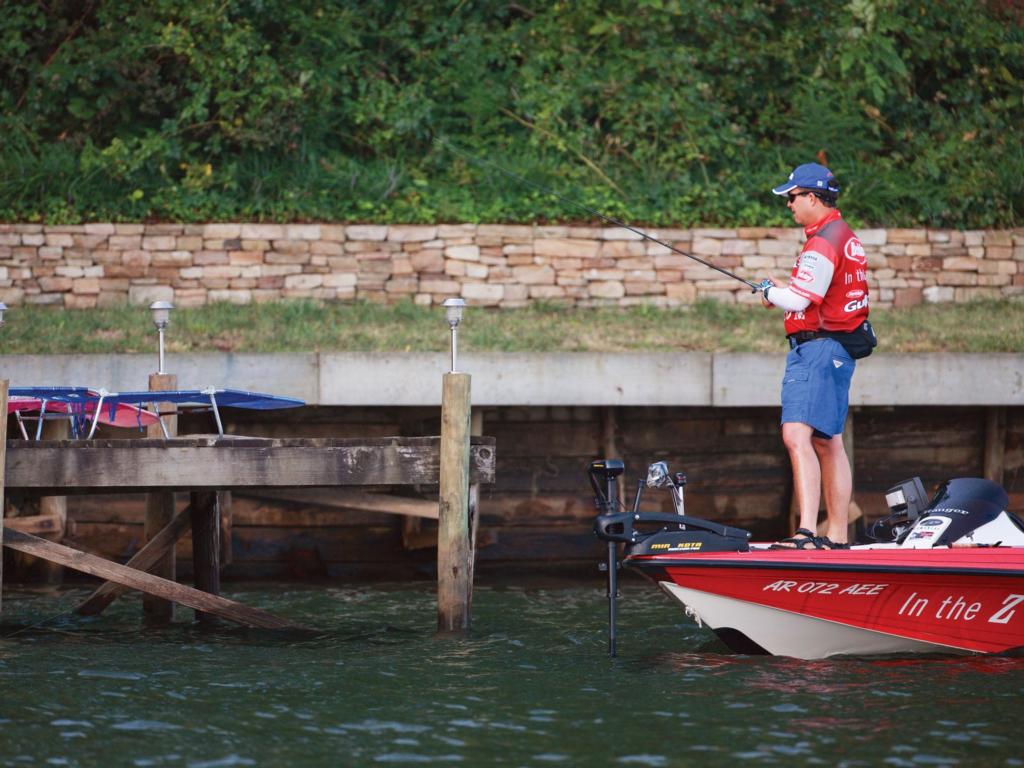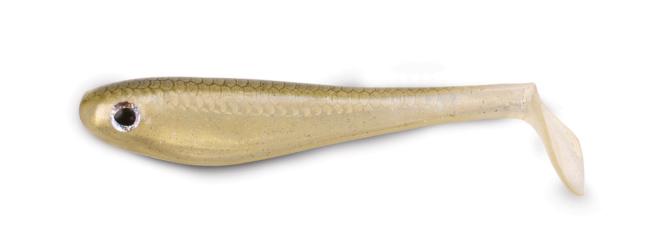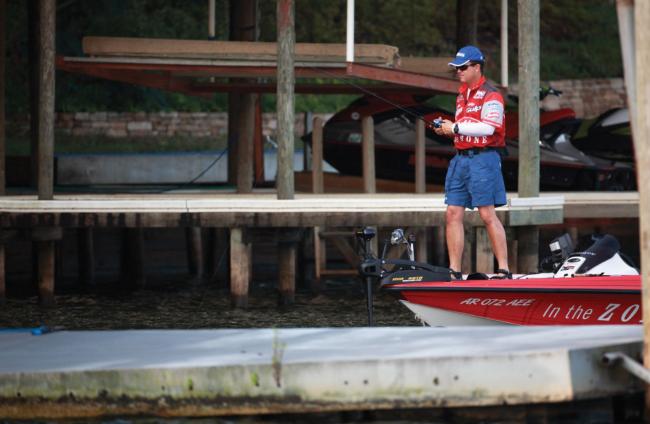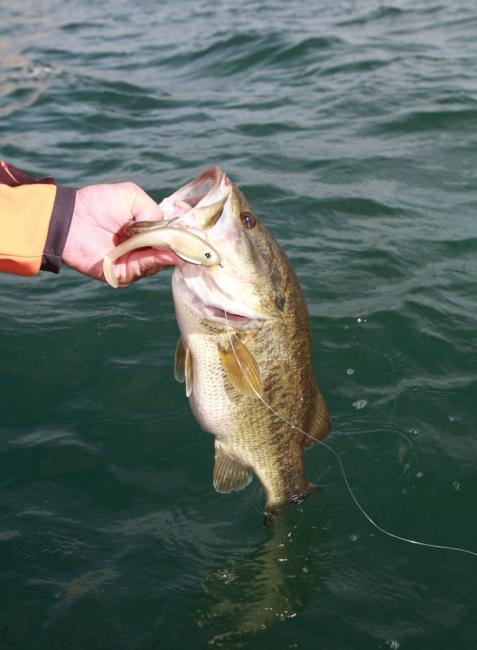Swimbaits and boat docks
For best results, replace finesse tactics with swim tactics near boat docks

Largemouth bass are object nuts. Mother Nature genetically programmed bass to position themselves around submerged cover and structure. Give a bass timber, bushes, stumps, brush or grass, and chances are good it will be as cozy as a bug in a rug.
Much the same could be said about boat docks, boat houses, boat slips and piers. Whether floating or permanently anchored by wood or metal pilings, the man-made shoreline structures offer a wealth of potential holding spots for largemouth bass.
Bass are attracted to boat docks for a number of reasons. Not only do they help satisfy their desired sense of security, docks also afford bass sanctuary where they can loaf in the shade on a sunny day. Additionally, docks provide bass a multitude of good hideouts for bushwhacking unsuspecting baitfish that use them to seek shelter from all the hungry mouths out there. In some instances, boat docks may account for the only form of suitable habitat a reservoir has to offer.
Bass anglers have learned to catch bass around boat docks using a variety of lures and prescribed fishing techniques. Flipping with soft plastics or jigs has a rich history around docks. So does casting with spinnerbaits, jerkbaits, crankbaits, soft jerkbaits, topwaters and shaky heads.
Ah, but we must not forget those trusty swimbaits, either.
California anglers have been relying on swimbaits to pluck giant bass off boat docks for years. Although the Western trend has been slow to catch on elsewhere, it is gradually beginning to factor into tournament outcomes in other parts of the United States every now and then.
Wal-Mart FLW Tour pro Jay Yelas of Corvallis, Ore., did his part last year to prove the swimbait is not just a Western thing anymore. The 42-year-old pro took the swimbait back East in 2007 and used it to the tune of more than $194,000 in earnings over six Wal-Mart FLW Tour events en route to winning his second Land O’Lakes Angler of the Year title since 2002.
Yelas earned checks in five tournaments but did the bulk of his damage at the Wal-Mart FLW Tour National Guard Open on Lake Norman in Concord, N.C., and the Wal-Mart Open tour event on Beaver Lake in Rogers, Ark. He finished second in both events. Interestingly, he relied heavily on boat docks and a soft-plastic swimbait rigged Texas style to get him there.
“The swimbait played a huge role in my success last year,” Yelas said. “Probably 90 percent of the fish I weighed at Beaver and Norman came on swimbaits I was fishing around boat docks. I also used it in open-water situations at the Detroit River event and the Fort Loudoun-Tellico Lakes event to catch a high percentage of my key fish over the course of those tournaments.”
A Western native, who at the time resided in Tyler, Texas, Yelas said his decision to throw a swimbait last season when much of the field was relying on shaky heads and other finesse baits to fill their limits on heavily pressured waters was one based strictly on a hunch.

“I always keep an open mind and try to come up with new ways to fool these fish,” Yelas said. “After seeing how successful swimbaits have been out West, I figured there was no reason bass in other parts of the country wouldn’t eat them if the conditions were right. Plus, I figured it was a bait the fish hadn’t seen much of in those lakes. I had a hunch it would work, and I’ll be darned if it didn’t.”
The fact Yelas was able to put together such a stellar season using swimbaits came as no surprise to Wal-Mart FLW Tour pro Art Berry of Hemet, Calif. Berry has been addicted to swimbait fishing since he was a kid. Today, he is recognized as one of the West’s most respected swimbait experts and accomplished bass pros.
We recently caught up with the two anglers and asked them to share some of their secrets for working swimbaits around boat docks.
Baits for heavy pressure
Swimbaits come in an assortment of sizes ranging from 2 inches to upward of 10 inches. Yelas leans toward a weedless soft-plastic bait 5 to 6 inches in length when targeting shallow-water bass on a tournament lake where the bite is relatively tough.
His favorite is the new Berkley PowerBait Hollow Belly, a 5-inch swimbait he helped develop. The Hollow Belly features a paddle tail and a hollow midsection that allows for easy hooksets and compresses when fish bite it. Yelas rigs the bait Texas style on a 6/0 wide-gap Mustad hook with a 1/16-ounce weighted shank.
The bait’s paddle tail displaces gobs of action, and the front half of the body has a tight, side-to-side roll when reeled at a slow-to-medium retrieve. The bait also skips extremely well – a major plus when it comes to reaching those dark, shady corners where lunkers often retreat when the sun is high or fishing pressure is heavy. The Hollow Belly is available in six colors.
Critical conditions
Swimbaits are most effective around boat docks when certain conditions exist. Yelas ranked clear water at the top of the list.
“The swimbait is a visual thing; the fish have to be able to see it for it to be effective,” Yelas said. “Personally, I prefer at least 3 feet of visibility before I will put much confidence in a swimbait.”
Swimbaits work any time intensive sunlight presses bass to take refuge in shady areas, but Yelas thinks they tend to shine the brightest at times of the year when bass are prone to move to shallow water.
Find bait, find bass
When Yelas begins his search for bass on a lake where boat docks are in abundance, he spends his time looking for concentrations of baitfish as opposed to searching for docks that look fishy.
“When I go fishing, I look for baitfish in areas where I think the bass should be rather than looking for the best looking docks,” Yelas said. “It could be in the backs of creeks, main-lake banks or on rock bluffs. A dock is just a cover bass use to ambush their prey. If the shad are there, the bass are going to be there.”
The right docks
Boat docks come in many shapes and sizes. Some are built on pilings, while others ride the surface on plastic foam or plastic floats. Yelas thinks floating docks are more conducive to good results on a swimbait than stationary docks built on pilings.
 “Docks on pilings are usually elevated above the water, whereas floating docks sit right on the surface,” Yelas said. “The closer the dock is to the surface, the higher in the water column the fish are likely to suspend when they are chasing shad. The swimbait is a natural in that situation. It works close to the surface, looks like a shad and swims like a shad.”
“Docks on pilings are usually elevated above the water, whereas floating docks sit right on the surface,” Yelas said. “The closer the dock is to the surface, the higher in the water column the fish are likely to suspend when they are chasing shad. The swimbait is a natural in that situation. It works close to the surface, looks like a shad and swims like a shad.”
Jockey for boat position
Yelas always positions his boat so he has the best casting angle on the target dock without getting so close he risks spooking fish that might be holding at the outer fringes. The idea is to work the bait parallel to the dock, a foot or so beneath the surface.
“The size of the dock dictates how I’ll fish it,” Yelas said. “Some docks are small enough that you can cover them with one cast, whereas a houseboat slip that is 60 to 70 feet deep might require 2 to 3 casts. I’ll work the outer fringes first, then move in tight so I can work it all the way to the back.”
Yelas’ tackle tips
Yelas likes a rod with some backbone, but pointed out the rod shouldn’t be so long that it hampers accuracy when making precision roll casts into tight quarters. His rod of choice is a 7-foot, medium-heavy Fenwick Techna AV Triggerstick AVC 70MHF. He tops it with a smooth-casting Abu Garcia Revo Premier 6.4:1 gear ratio baitcaster spooled with Berkley Trilene XT, 17- to 20-pound test.
“XT is a monofilament, so it doesn’t sink like fluorocarbon,” he said. “That helps keep the swimbait close to the surface, even on a slow retrieve. Plus, it is very abrasion-resistant, so it will hold up against cables, boat propellers, rebar and other sharp stuff typically found around boat docks.”
Picking a swimbait
Not all swimbaits are created equal. Some are hand-poured from premium plastic; others are made from materials of lesser quality. According to Berry, the best swimbaits for dock fishing are those that achieve the most action and stay up in the water column at an ultraslow retrieve.
An easy way to choose a good soft-plastic swimbait is to hold it vertical by the midsection with the head pointing down. The best ones are soft to the touch and have a fairly limp tail section. “If the tail folds over, it’s a good one. If the tail points straight up, it’s not going to have much action at a slow retrieve. You will have to retrieve that bait way too fast to get the action out of it.”
Berry’s preferred swimbaits for dock fishing are a California Swimbabes Baby “E”or a Tiny “E.”
Perfecting the skip
At times bass will retreat so far beneath a dock it is impossible to get a lure to them using a conventional casting technique. That’s why Berry thinks it is important to master the underhand “skip-cast.”
“Knowing how to skip is essential so you can reach those secluded nooks and crannies,” he said. “And the neat thing is that it is pretty easy to accomplish with the swimbait because it skips so well – almost like a flat rock.”
A low-trajectory presentation is necessary to skip a swimbait effectively. Berry achieves it by making an underhand roll cast. Keeping his rod tip low, he tries to launch the bait no more than 6 inches above the surface. Performed correctly, the bait’s forward momentum will cause it to skip across the surface when it contacts the water.
 “It is no different than skipping a rock,” Berry said. “You have to release a rock low to the water to skip it effectively.”
“It is no different than skipping a rock,” Berry said. “You have to release a rock low to the water to skip it effectively.”
Match the hatch
Swimbaits are available in a variety of size and color patterns. Anglers can boost their odds of success with swimbaits by researching the lake they are visiting to learn about the predominant forage fish available.
“When most people think of swimbaits, they think of a big ole’ 12-inch rainbow trout,” Berry said. “Nowadays, we’ve got swimbaits to match just about anything the bass feed on – blueback herring, crappie, bluegill, etc. Your odds of success will go up exponentially if you match the hatch at the lake you are fishing.”
Let it swim
Many anglers have a tendency to overwork a swimbait by twitching or jerking the lure during the retrieve.
“That is not what a swimbait is about,” Berry said. “A swimbait is at its best when it is swimming very slow and displacing lots of action all on its own. It is equally important to work the lure all the way back to the boat. A lot of strikes come during the last 10 feet of the retrieve.”
Key docks
During early spring, Berry likes to target floating docks that are transparent, which allows the sunlight to shine through and warm the water below.
“It’s just like having a solar blanket wrapped around the water,” he said. “The water right below the dock will be substantially warmer than everything else around. The bass will gravitate to it like a magnet.”
On lakes with excessive numbers of docks, Berry tries to avoid getting bogged down and wasting time by attempting to check every dock in a particular bay. Instead, he dissects “sections” of docks by fishing the first and last two on a row. Then he’ll fish the docks in the middle that stick out the farthest into the water. Isolated docks also get some attention.
Throw ’em a change-up
Seldom are two tournament days the same, especially on heavily pressured waters. Let’s say you catch a few fish around docks swimming a jig or shaky head and lose a few more, and then the bite suddenly wanes.
“Come back the next day with a swimbait and see what happens,” Berry said. “It’s a little extra arsenal to your package that can pay off big time if you will give it the chance to work. More and more anglers are beginning to realize that.”
Tackle: Don’t overdo it
Many anglers are inclined to think they need braided line, a big rod, a big reel and oversized hooks to fish a swimbait around docks effectively. It’s just not so.
“That is the exact mentality that gets the followers, missed strikes or no bites at all,” Berry said. “I fish my swimbaits on the same type of tackle I use with spinnerbaits, jigs and worms.”
Berry’s swimbait system consists of a 7-foot Dobyns rod (heavy action) and an Abu Garcia Revo reel spooled with 14- to 17-pound-test Berkley Trilene Big Game mono.
“The purpose of the mono is to provide some shock absorption so the fish can eat the bait,” he said. “Braid is a no-no, because it is too direct of a connection.”
Fishing docks will always be a tournament-winning pattern on some lake during some season. Every dedicated tournament angler knows this. To bring in the big bass and bring home a check, try tying on a swimbait and giving the fish something new to chew on.